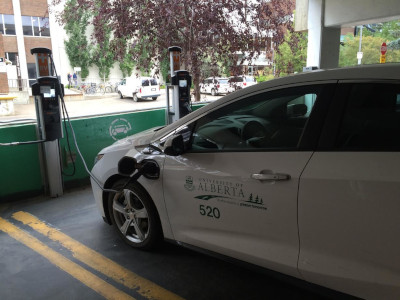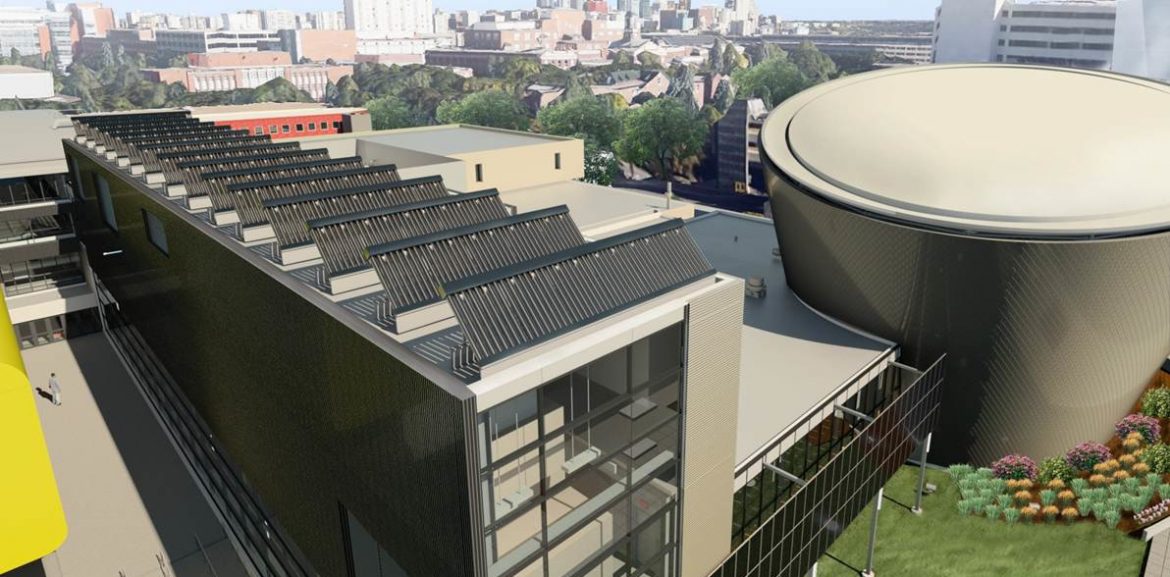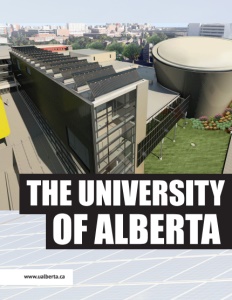The University of Alberta
A leader in sustainability
Business View Magazine interviews representatives of the University of Alberta as part of our focus on sustainable programs and practices.
The University of Alberta is a public research university located in Edmonton, Alberta, Canada. Founded in 1908, today, the U of A comprises five campuses: North Campus, South Campus, Enterprise Square, and Campus Saint-Jean in Edmonton, and Augustana Campus in the city of Camrose. The University has over 39,000 students from Canada and 150 other countries who participate in 400 programs in 18 departments. The U of A has consistently ranked as one of the top five universities in Canada and one of the top research universities worldwide. It is a major economic driver in the province; with 15,000 employees, it ranks as Alberta’s fourth-largest employer.
 In addition, the U of A is a long-time leader in the area of sustainable practices and energy management programs. Over 40 years ago, in order to reduce costs, the University began incorporating sustainability into its facilities and operations, focusing on the reduction of resources—electricity, water, natural gas—used to power its buildings and infrastructure. It is estimated that the U of A’s energy management has saved it over $350 million since 1975, not to mention a concurrent reduction of 2.5 million tons of greenhouse gas emissions.
In addition, the U of A is a long-time leader in the area of sustainable practices and energy management programs. Over 40 years ago, in order to reduce costs, the University began incorporating sustainability into its facilities and operations, focusing on the reduction of resources—electricity, water, natural gas—used to power its buildings and infrastructure. It is estimated that the U of A’s energy management has saved it over $350 million since 1975, not to mention a concurrent reduction of 2.5 million tons of greenhouse gas emissions.
Currently, the university’s district energy system, the fifth-largest campus system in North America, efficiently heats and cools the entire North Campus using cogeneration and natural gas fuel. The cooling plant on campus produces and stores chilled water in a thermal energy storage system during off-peak hours when power prices are lower. The Jeanne and Peter Lougheed Performing Arts Centre on the Augustana Campus boasts the largest building-integrated solar photovoltaic system in Canada, with 488 solar panels. Approximately 780 kilowatts of renewable and alternative energy capacity is planned to be installed institution-wide by 2020.
Business View Magazine first spoke with representatives of the U of A’s Office of Sustainability in 2017, and more recently with Robert Summers, Academic Director, University of Alberta Sustainability Council; Associate Director, Urban and Regional Planning, Department of Earth & Atmospheric Sciences, Faculty of Science; and Shannon Leblanc, Program Coordinator, Energy Management and Sustainable Operations, to learn about some changes in the University’s sustainability operations.
BVM: What changes have occurred on campus since last year?
Summers: “We’ve actually had a rather major shift take place. Previously, the Office of Sustainability led the overall sustainability effort for the University. In January, the decision was made to, essentially, split that unit into two, one of those being the University of Alberta Sustainability Council. That name was chosen to demonstrate that this was something that represents all faculties across campus. This unit will take on all of the academic initiatives that the Office of Sustainability had before, as well as look to launch new initiatives, thus expanding upon our academic sustainability programming.
 “When this transition took place, one of the things we were aware of is that the University of Alberta has a real strength in researchers who focus on various aspects of sustainability – from environmental sustainability, to social sustainability, to economic sustainability – and we have programs that target certain elements of that. We didn’t have a central spot on campus that networked these groups together effectively, and connected instructors, researchers, and others in a way that built synergies amongst them beyond what they’ve already done, themselves.
“When this transition took place, one of the things we were aware of is that the University of Alberta has a real strength in researchers who focus on various aspects of sustainability – from environmental sustainability, to social sustainability, to economic sustainability – and we have programs that target certain elements of that. We didn’t have a central spot on campus that networked these groups together effectively, and connected instructors, researchers, and others in a way that built synergies amongst them beyond what they’ve already done, themselves.
“So, the role of the new unit is, in part, to do that – to connect people, to provide information, to build certain programming structures. One of our existing programs, the Certificate in Sustainability that our students can take as part of their degree program has been in place for a number of years. We are looking to raise awareness of the program, which we expect will expand the number of students taking the Certificate program. We are also looking to develop some courses that are very specific to that program, that will help our students navigate the breadth of sustainability learning and to empower them to better engage across different approaches to sustainability.
“We see potential for an introductory course in sustainability which is a notion introduced in our Academic Sustainability Plan a few years ago. My own hope would be to have all students going through the University taking such a course. I see such a course as helping students navigate the diverse and complex ways that different disciplines approach sustainability. As an example, a student might take a course in one discipline where they critique the current global economic system and the role of capitalism in creating an unsustainable trajectory for global societies. Then, they might take a course in economics in which environmental challenges are considered as ‘collective action’ problems, and different economic tools such as environmental taxes are presented as a means to addressing them. Students may struggle to understand how and why there are different perspectives and approaches to sustainability. We are hoping to offer one or more courses that help empower students to understand this.
“We’re also looking at ways to develop transformative courses, where students have experiences that truly and deeply change either their perspective or their knowledge base; courses that have a huge experiential component – a large project with a client, a research project with an academic, or cases where they can go on a field study, perhaps overseas to different parts of the world.
“We also have the Sustainability Scholars Program, which we’ve expanded to include more employers. A few years ago, it was just the City of Edmonton and the University of Alberta that were employing students. These are graduate students who go out and do an applied internship program with an employer. We’ve added four more employers to that, and next year, we plan to expand that further.
“Campus as a Living Lab is another existing program that we’ll be looking to expand. This program focuses on supporting research on sustainability within the campus environment itself. We know we can help connect people and build networks and bring people together for events where we profile both local researchers, as well as researchers we bring from outside. We are already working with our Facilities and Operations group to explore funding models for students and faculty members to undertake research projects on campus. “
Leblanc: “The other half is Facilities and Operations. A lot of the existing initiatives within the Office of Sustainability were partnerships with Facilities and Operations, around campus sustainability work – things that impact buildings, grounds, energy, waste, water, greenhouse gasses – those sorts of things. A lot of those programs that are focused on sustainable operations will be housed within Facilities and Operations, with a leadership role from Energy Management and Sustainable Operations, or EMSO.
“EMSO will continue a lot of the work focused on reducing the environmental impact of the University’s operations, and we’ll continue to work really closely with other units on campus that are service providers, operational units, and across facilities and operations, as well. We hope to partner with the new Sustainability Council on initiatives that allow researchers and students to do work that focuses on campus, something that’s become commonly known in the sustainability community as ‘campus as a living lab’ or ‘experiential learning opportunities’ for students. We will also seek opportunities for researchers where we can partner to make improvements to operations using a research or learning approach.
“I also want to speak a little bit about our Greenhouse Gas Inventory because it fits really well with what we had before around our district energy system, and our energy management program, and several other topics that we deal with in Facilities and Operations. The Greenhouse Gas Inventory tracks emissions data from both our onsite, district energy system, as well as our purchased electricity. The Inventory also goes beyond energy emissions to capture other sources of greenhouse gas emissions at the University – from things like solid waste, wastewater, agricultural research animals, fleet vehicles, fertilizer used in landscaping, and much more.
 “So, we’ve got a pretty comprehensive inventory and it’s been a great way to measure progress towards our emission reduction goals of 17 percent below 2005 levels by 2020. Since 2012, when we first conducted our Inventory, we’ve reduced our emissions by approximately eight percent, and we’re always trying to improve our methodology and grow the Inventory, as well. To that end, we’ve begun to look at emissions sources like how students are commuting to campus every day, or business-related air travel.
“So, we’ve got a pretty comprehensive inventory and it’s been a great way to measure progress towards our emission reduction goals of 17 percent below 2005 levels by 2020. Since 2012, when we first conducted our Inventory, we’ve reduced our emissions by approximately eight percent, and we’re always trying to improve our methodology and grow the Inventory, as well. To that end, we’ve begun to look at emissions sources like how students are commuting to campus every day, or business-related air travel.
“Another program that we’re pretty excited about is our water management program. We’ve started a University-wide conservation program that’s investing in water efficient technology and water fixture upgrades, and we’re tying that in with other ongoing maintenance work, in order to reduce our water use at the University.
“Another thing that’s happening – not just at the University, but around us, in Edmonton – is a shift to include more active transportation modes. The north campus of the University, which is our biggest campus, sits right in the middle of a lot of new cycling infrastructure that the City of Edmonton is installing. We have initiated an active transportation advisory group that is exploring ways to improve facilities on our campuses to support more sustainable and active transportation options for all campus community members.
“Finally, there’s the Green Spaces Program available to offices, labs, events, food vendors, and residences. This is a program that was developed by the former Office of Sustainability and is a fantastic way for us to connect with different groups across the University that might not otherwise have an easy way to engage with sustainability. The Green Spaces Program allows different groups on campus to rate themselves on how they’re doing with day-to-day sustainability practices and gives them ways to improve, while teaching them about systems on campus and how to improve their own sustainability within their everyday work.”
Check out this handpicked feature on the Saint Louis University Office of Sustainability and Benchmarking.
AT A GLANCE
WHO: The University of Alberta
WHAT: A world-renowned research institution
WHERE: Edmonton, Alberta
WEBSITE: www.ualberta.ca




